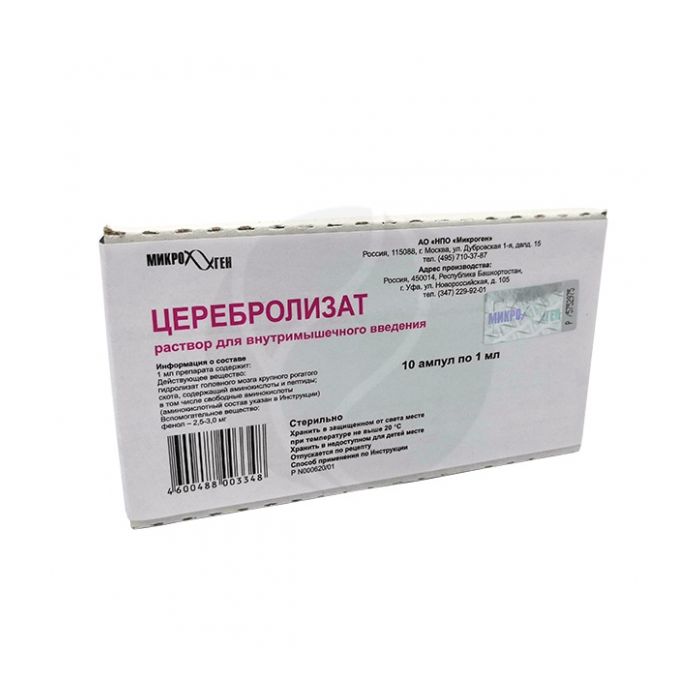Cerebrolysate solution, 1ml No. 10
Expiration Date: 05/2027
Russian Pharmacy name:
Церебролизат раствор, 1мл №10
disorders of cortical functions of the brain caused by cerebral circulation insufficiency,
discirculatory encephalopathy (of various origins),
condition after traumatic brain injury (including asthenic syndrome).
Intramuscularly, 1-5 ml daily or every other day, the course of treatment is 20-30 days.
After a 36 month break, the course of treatment can be repeated.
Cerebrolysate is a product of enzymatic hydrolysis of the brain of cattle, containing free amino acids and peptides. Phenol is a preservative for the preparation in the amount of 0.3%.
Amino acid composition of cerebrolysate fluctuates within the following limits in milligrams per milliliter (mg / ml):
L-Lysine 0.95-2.85
L-Histidine 0.30-0.90
L-Arginine 0.80-2.60
Aspartic acid 1.00-2.60
L-Threonine 0.70-2.10
Serine 1.35-3.25
L-Glutamic acid 3.75-6.25
L-Alania 1.75-5.25
L-Proline 0.70-1.70
Glycine 0.70-2.10
L-Valine 1.35-4.05
L-Methionine 0.65-1.95
L-Leucine 2.00-6.00
L-Phenylalanine 0.50-1.50
Isoleucine 0.80-3.60
Tyrosine 0.15-0.65
Hypersensitivity.
With caution in: acute renal failure, allergic diathesis, generalized convulsive seizures, pregnancy (I trimester).
Trade name: Cerebrolysate
Dosage form:
solution for intramuscular administration.
Composition:
Cerebrolysate is a product of enzymatic hydrolysis of the brain of cattle, containing free amino acids and peptides. Phenol is a preservative for the preparation in the amount of 0.3%.
Amino acid composition of cerebrolysate fluctuates within the following limits in milligrams per milliliter (mg / ml):
L-Lysine 0.95-2.85
L-Histidine 0.30-0.90
L-Arginine 0.80-2.60
Aspartic acid 1.00-2.60
L-Threonine 0.70-2.10
Serine 1.35-3.25
L-Glutamic acid 3.75-6.25
L-Alania 1.75-5.25
L-Proline 0.70-1.70
Glycine 0.70-2.10
L-Valine 1.35-4.05
L-Methionine 0.65-1.95
L-Leucine 2.00-6.00
L-Phenylalanine 0.50-1.50
Isoleucine 0.80-3.60
Tyrosine 0.15-0.65
Description: Transparent yellowish liquid.
Pharmacotherapeutic group:
nootropic agent.
Pharmacological properties
Strengthens the synthesis of proteins in nerve cells, increases the resistance of the brain tissue to intoxication, hypoxia, hypoglycemia. It activates integrative processes in the central nervous system, improves concentration of attention, memorization processes.
Pharmacokinetics
Pharmacokinetic analysis is difficult due to the complex composition, including free amino acids and peptides.
Indications for use
Disorders of the cortical functions of the brain caused by insufficient cerebral circulation, discirculatory encephalopathy (of various origins), a condition after traumatic brain injury (including with asthenic syndrome).
Contraindications:
Hypersensitivity.
With caution in: acute renal failure, allergic diathesis, generalized convulsive seizures, pregnancy (I trimester).
Method of administration and dosage
Intramuscularly, 1-5 ml daily or every other day, the course of treatment is 20-30 days.
After a 36 month break, the course of treatment can be repeated.
Side effect
Injections of the drug are painful, in some cases tissue irritation at the injection site is possible. With hypertension II-III Art. during the period of treatment with cerebrolysate, an increase in blood pressure may occur.
Overdose:
There is no information.
Application during pregnancy and lactation
It can be used during pregnancy and lactation under medical supervision.
Release form
Solution for intramuscular administration in ampoules of 1 ml; 10 ampoules with instructions for use in a cardboard box.
Storage conditions
In a dark place at a temperature not exceeding 20 ? C. Keep out of the reach of children.
Shelf life:
3 years. Do not use after the expiration date.
Terms of dispensing from pharmacies:
On prescription.

